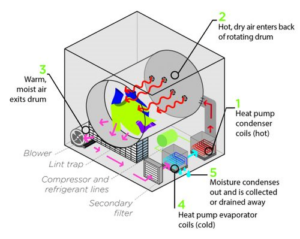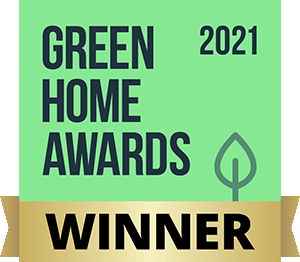In winter, when extreme weather events like the recent storm Isha and Jocelyn are battering the country, you cannot dry your clothes outdoors unless you enjoy collecting sodden smalls from your neighbour’s monkey puzzle trees.
At this time of year, we all must dry our clothes indoors. But this seemingly simple and innocuous chore can impact our homes’ comfort, health and energy efficiency. In particular, on its air quality, which in turn can increase the risks of dampness and mould that can severely impact the health of inhabitants.
Recently, the BBC published an article about a surge in the sale of dehumidifiers as a solution to helping dry clothes indoors. As well as helping to keep humidity in the house low enough to avoid dampness and mould.
But all is not as simple as it sounds. In this blog, our MVHR Technical Support Specialist, Anna–Marie Byrne, takes a closer look at the article’s claims and provides her opinion on what we can consider when drying out winter thermals indoors at this time of year.
Air Quality is more than just about humidity.
This article suggests that dehumidifiers can solve a few problems in the home. But a couple of issues here don’t make the solution so clean-cut.
The first thing to consider is that indoor air quality is affected by many pollutants, not just water vapour. Focusing on keeping the humidity of the air good without considering other pollutants can lead to very poor indoor air quality. Multiple other pollutants created in the house require you to ventilate the house and not just use a dehumidifier. Good ventilation also helps to keep the following pollutants at safe levels:
- CO2 from breathing,
- NOx from burning fuel (e.g. gas hob),
- particulates (e.g. candle smoke, fragrance burners),
- bacteria and viruses,
- VOCs from household sprays, paint,
- Formaldehyde
- Radon from the ground and others.
We have written about ventilation and dehumidifiers before, and you can read more in this previous blog. But in essence, using a dehumidifier instead of good ventilation can keep humidity levels at good levels; it will lead to poor indoor air quality and potentially poor occupant health. Ensure good ventilation, like with an MEV or MVHR system, no dehumidifier should be needed to keep humidity levels optimal, even if drying clothes indoors.
The second issue that the article suggests and needs closer scrutiny is the comparison between drying clothes using a tumble drier and a dehumidifier. Simply put, it is not a straightforward like-for-like comparison; the figures quoted in the BBC article do not give the full picture. To understand this better, it’d be useful to understand what’s happening when you dry clothes.
What happens when you dry clothes?
When it comes to drying clothes, it’s worth considering it in terms of two processes – drying the clothes and drying the air.
Process 1 – Drying the clothes
To evaporate water from wet laundry takes energy (the latent heat of evaporation). This is about 3kWhi (units of energy) for a 5kg load of washing. If the energy used is electricity, this would cost about £1. If the energy used is gas heating, this would cost about 30p.
The energy to dry clothes comes from:
- the heat in the indoor air if hung indoors or
- the heat in the outdoor air if hung outside or
- the hot air is blown through the drum of a tumble drier.
A dehumidifier doesn’t dry clothes. It’s the heating system in the house that dries the clothes. And because the dehumidifier uses electrical energy to run (about 1.5kWh to take 5kg of moisture out of the air), it will contribute to heating the air in the house. Dehumidifiers use an expensive source of power (electricity) rather than the cheaper one used for space heating (gas).
Process 2 – Drying the air
Once the clothes are dried, you’ve got dry washing and wet air; i.e. the water in the washing is now present in the air as water vapour. This is not a problem if the clothes are outdoors; it just blows away. If you’re using a heat pump tumble drier, the wet air is now inside the tumble drier and the moisture is taken out of the air inside the tumble drier by condensing the moisture on a cold surface created by the heat pump.
However, hanging wet clothes indoors means the humidity of the indoor air has risen. In the UK, a medium-sized house with inadequate ventilation in the winter will probably raise the humidity to over 60% relative humidity and, therefore, is likely to be humid enough to condense on cold walls and windows in the house, making them damp and creating conditions suitable for the growth of mould.
At times, when we have to dry our washing indoors, to avoid the problem of overly humid indoor air, we have to find a way to get rid of the water vapour from the air. This can be done either by
- Removing the humid air and replacing it with dry air, i.e. ventilating using mechanical extract ventilation (MEV) or
- By condensing the water back to a liquid and removing the liquid from the house. Condensing the water vapour releases the same energy from the water back into the air as it took to evaporate it from the clothes in the first place. So, the energy it takes to dry the clothes is fully or partly reclaimed back into the air. Condensing options from the indoor air are:
- 2a. An MVHR (Mechanical Ventilation with Heat Recovery) unit that uses fans to create a cold surface blowing cold outdoor air through the heat exchanger, enabling the warm wet air to condense on the heat from this process to be transferred to the incoming dry air.
- 2b. A condensing dehumidifier also creates a cold surface similar to the heat pump tumble drier but uses the air in the room rather than the air in the tumble drier.
Options 2a and 2b and the heat pump tumble drier all condense water back out of the air, reclaiming some or all of the latent heat.
In Summary
The table below summarises the options in terms of running costs, upfront costs and indoor air quality when it comes to drying clothes indoors:
| Cost of drying 5kg of washing | Cost of running for a day | Indoor air quality | Upfront costs | ||
| 1 | Hang clothes indoors, demand-controlled MEV | ~50p | ~50p | Good | ~ £500 |
| 2a | Hang clothes indoors, MVHR | ~50p | ~50p | Excellent | ~£5000 |
| 2b | Hang clothes indoors, inadequate ventilation, condensing dehumidifier | ~50p | ~£1.25 on full power all-day | Poor, but less potential mould than option 4 | ~ £200 for a medium-sized house |
| 3 | Tumble drier, inadequate ventilation | ~50p | n/a | Poor, but less potential mould than option 4 | ~ £500 for the best heat pump dryers |
| 4 | Hang clothes indoors, inadequate ventilation | free | free | Terrible: likely mould, possible illness. | free |
A more detailed look at the options
-
Mechanical Extract Ventilation
(The best budget air quality solution)
The first option is removing the humid air and replacing it with dry air; this is most effectively achieved by continuous mechanical extract ventilation (MEV). We consider other ventilation options, except MVHR, as inadequate:
- Intermediate ventilation is inadequate in terms of the amount of air extracted because it’s not moving air at all most of the day.
- Continuous input ventilation or positive input ventilation (PIV) is ill-advised because it drives the humid air out through any gap in the building fabric, and some of these gaps will be through places where they will condense inside the building fabric and cause damp problems (interstitial condensation).
For a household on a budget with a damp problem, MEV is our go-to recommendation. Continuous mechanical extract ventilation will ensure the humidity of the air is optimal (between 40-60% Relative Humidity) even if drying clothes indoors. And it will ensure all the other indoor air pollutants (CO2, VOCs, particulates, odours, NOx, SOx and pathogens) are safe. The electrical energy used to run the fans is minimal, under 10W for a medium-sized house (0.25kWh per day or about 8p per day).
The disadvantage of MEV is that you are losing both the heat in the air and the energy in the water. This means you need to spend more on heating the house. A partial solution to this problem is to use demand-controlled MEV: the fans always extract air to ensure good indoor air quality, but they ramp up and down according to need. This roughly halves the heat loss due to extracting warm air. For a medium-sized house, the heat losses due to demand-controlled MEV are about 3kWh/day, costing whatever your heating fuel costs to provide that (about 30p/day for gas heating). Fitting MEV fans into a medium-sized house with labour and materials costs £500 in upfront costs.
2a. MVHR unit
This has high upfront costs but is the best ventilation you can get, giving you the most healthy indoor environment possible. Clothes hung indoors to dry will dry fast and without needing a dehumidifier or tumble drier. In such systems, 90% of the heat in the air is reclaimed and using a Passivhaus-certified MVHR unit means you will need less energy to heat your house. This is why MVHR systems are necessary for Passivhaus construction in our climate. A cold surface is created in the heat exchanger by the cold air outside passing through it, allowing the MVHR unit to reclaim both the warmth in the air (sensible heat) and the heat in the water vapour (latent heat of condensation). This is because the moisture condenses in the heat exchanger, transferring its heat to the incoming air.
An MVHR system needs electrical energy to run the fans to move the air through the heat exchanger. A well-designed system in a medium-sized house would use about 0.75kWh/day of electricity (about 25p). About 10% of the heat from the air is lost to the outside because the heat recovery isn’t 100% effective. For a medium sized house and a sound MVHR system, this is about 1.3kWh/day of whatever fuel the heating system uses (about 13p/day for gas heating).
The only other cost in an MVHR system is the filters for air entering and leaving the house. The filters are needed to keep the heat exchanger clean, so it works effectively. The filters will also greatly improve the indoor air quality. They expel pollutants created inside the house and replace the air with outdoor air, as MEV does. The outdoor air is filtered of particulates before entering the house. The filter can also be upgraded to remove pollen and other allergens. Filter costs are between 10-25p per day.
2b. Dehumidifier
A condensing dehumidifier creates a cold surface for moist air to condense on and blows the room air over it. To make this cold surface, the dehumidifier needs to put energy into a heat pump, just as a fridge needs electrical energy to cool itself. Although five litres of water condensing releases about 3kWh of energy, to get 5 litres of water out of the air, an efficient dehumidifier needs to use about 1.5kWh of electricity (costing about 50p at 35p/kWh). For a good quality dehumidifier for a medium-sized house, this would take about 10 hours and two empties of its tank. The electrical energy put into the house by the dehumidifier finally ends up as heat in the air, which will offset half of the heating to dry the clothes in the first place, although more often than not by using an expensive fuel (electricity) rather than a cheap one (gas heating).
3. Heat Pump Tumble Drier

The heat pump tumble dryer is another option that keeps all the air in the process enclosed within. This is the most efficient type of tumble drier in terms of energy use (they are slower to work than condensing tumble driers). As described above, this heats the clothes to dry them and then condenses the water out of the humid air on a cold surface created by the cooling part of a heat pump. The latent energy of condensation released into the heat pump refrigerant contributes to the heating coil heating the air to dry the clothes. The evaporated water is then condensed, and in a perfect system, this would take no net energy at all. However, running the refrigerant around the system takes energy, creating cold and warm surfaces much like a fridge. For an efficient tumble drier, this amounts to about 1.2kWhii for a 5kg load of washing. (42p when electricity costs 35p/kWh).
4. Drying clothes indoors with inadequate ventilation
This causes humidity to rise and moist air to condense on cold surfaces, creating dampness and mould. Air quality is terrible, and there could easily be health problems for the occupants ranging from mild to severe.
In conclusion
Hopefully, this has explained why, of the options above, ventilating using either MEV (budget option) or MVHR (best option) is the best way to deal with moisture in the home and provide good indoor air quality regarding all other indoor air pollutants.
Of the other options, whether drying clothes using a heat pump tumble dryer or condensing dehumidifier, these will keep the air drier than not using them. However, suppose your clothes don’t easily dry indoors anyway. In that case, that indicates an inadequate ventilation problem in the house, and ventilation is always key to keeping the air healthy.










Leave a Reply